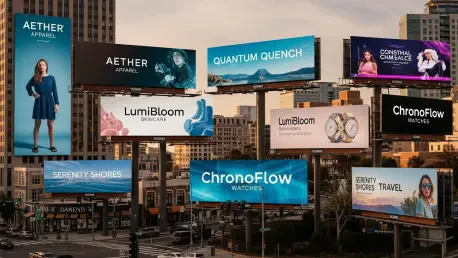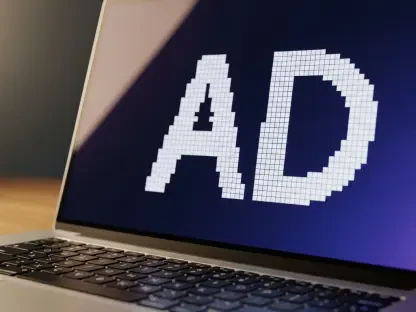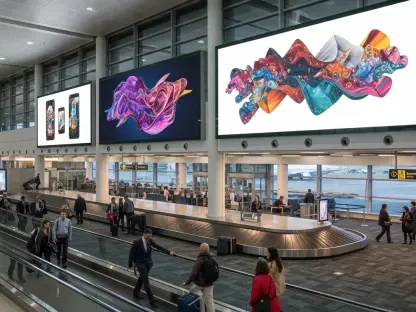The Rising Importance of Outdoor LED Screens in Digital Advertising
Imagine walking through a bustling city center, surrounded by towering digital displays that captivate with vibrant, dynamic content tailored to the moment—be it a flash sale triggered by the weather or a live event stream. This is the reality of digital out-of-home (DOOH) advertising in 2025, where outdoor LED screens have become the cornerstone of brand engagement in public spaces. These screens are no longer just billboards; they are interactive canvases that connect with audiences in real time, transforming urban landscapes into hubs of digital storytelling.
The significance of outdoor LED screens lies in their ability to deliver high-impact visuals that cut through the noise of crowded environments. Unlike static signage, they offer flexibility to update content instantly, making them indispensable for advertisers aiming to stay relevant. Their prominence is evident in high-traffic areas like transit hubs, shopping districts, and stadiums, where brands leverage their visibility to build instant recognition and drive consumer action.
The current market landscape reflects a robust ecosystem shaped by major players and cutting-edge technologies such as artificial intelligence (AI) and the Internet of Things (IoT). These innovations enable features like targeted ad delivery and real-time analytics, pushing the boundaries of what outdoor advertising can achieve. With the DOOH market projected to grow to USD 39.12 billion by 2030, according to industry estimates, the stakes are higher than ever for suppliers to deliver exceptional solutions that meet evolving demands.
Market Trends and Growth Projections for Outdoor LED Screens
Key Trends Shaping the Industry
The outdoor LED screen sector is witnessing a wave of transformation driven by trends that prioritize interactivity and precision. Programmatic advertising stands out as a game-changer, allowing brands to automate ad placements based on data insights, ensuring the right message reaches the right audience at the right time. Coupled with real-time analytics, advertisers can now measure engagement instantly and tweak campaigns on the fly for maximum impact.
Technological advancements are also redefining the visual experience with innovations like naked-eye 3D displays, which create immersive illusions without special glasses, and transparent panels that blend seamlessly into glass facades. Flexible screens are another breakthrough, enabling creative installations on curved or irregular surfaces, thus opening new avenues for architectural integration. These developments are not just aesthetic; they cater to a growing demand for unique, attention-grabbing formats in competitive markets.
Urbanization and the rise of smart cities further fuel the appetite for advanced advertising solutions. As global events and public gatherings increase, so does the need for large-scale, high-quality displays that can broadcast live content or interactive campaigns. This convergence of societal shifts and tech innovation underscores why outdoor LED screens are pivotal in shaping modern advertising strategies across diverse regions.
Market Data and Future Outlook
Delving into the numbers, the DOOH market is on a steep upward trajectory, with a compound annual growth rate (CAGR) of 10.7% projected from 2025 to 2030. This growth reflects a market size that continues to expand as businesses recognize the value of dynamic, data-driven advertising over traditional methods. The shift in consumer behavior toward seeking engaging, personalized content in public spaces is a key driver behind these impressive figures.
Several factors propel this expansion, including the increasing adoption of digital infrastructure in emerging economies and the growing preference for visually striking mediums that can adapt to real-time conditions. Advertisers are investing heavily in platforms that offer measurable returns, pushing suppliers to innovate and scale their offerings. The data suggests a clear pivot toward solutions that blend creativity with analytics for optimized outreach.
Looking ahead, opportunities abound in untapped regions and niche applications, such as temporary installations for festivals or disaster response communications. Suppliers who can anticipate these needs and offer tailored, scalable products will likely gain a competitive edge. The future of this sector hinges on balancing technological sophistication with accessibility to cater to a broadening client base hungry for impact.
Challenges in the Outdoor LED Screen Industry
Navigating the outdoor LED screen market is not without hurdles, particularly when it comes to technical reliability. Ensuring durability against extreme weather conditions—be it scorching heat, heavy rain, or freezing cold—remains a significant challenge. Screens must withstand these elements without compromising performance, demanding rigorous engineering and testing from suppliers to prevent frequent failures or costly replacements.
Beyond environmental factors, market-driven issues like high initial investment costs pose barriers, especially for smaller businesses or regions with limited budgets. Energy consumption is another concern, as outdoor displays often run continuously, prompting a push for energy-efficient designs that reduce operational expenses. These financial and ecological pressures compel the industry to rethink traditional models in favor of sustainable, cost-effective alternatives.
To address these obstacles, innovative approaches are emerging, such as modular designs that simplify maintenance and repairs by allowing individual components to be replaced without overhauling entire systems. Robust supplier support systems also play a vital role, offering clients quick troubleshooting and spare parts availability. By prioritizing resilience and service, the industry aims to mitigate risks and build confidence among advertisers facing these complex challenges.
Compliance and Standards for Outdoor LED Screen Suppliers
Quality and safety are non-negotiable in the outdoor LED screen arena, where compliance with international standards serves as a benchmark for credibility. Certifications like CE, RoHS, FCC, and ETL are critical indicators that a supplier meets stringent requirements for product safety, environmental impact, and performance. These endorsements assure clients of reliability in diverse operating conditions across global markets.
Adherence to such standards is not merely a formality; it reflects a commitment to environmental stewardship and operational excellence. For instance, compliance with RoHS ensures hazardous materials are minimized, aligning with sustainability goals increasingly valued by businesses and regulators alike. This dedication enhances a supplier’s reputation, fostering trust with clients who prioritize ethical and dependable partnerships in their procurement decisions.
The impact of compliance extends to long-term business practices, influencing how suppliers are perceived in competitive landscapes. Those who consistently meet or exceed regulatory expectations are better positioned to secure contracts in strict markets and build lasting relationships. As global scrutiny on quality intensifies, maintaining these standards becomes a strategic imperative for sustained growth and client satisfaction.
Future Directions for Outdoor LED Screen Technology and Suppliers
The horizon for outdoor LED screen technology is brimming with potential, as advancements like deeper AI integration promise to refine content personalization and scheduling. Imagine displays that predict viewer preferences based on historical data, delivering hyper-relevant ads with pinpoint accuracy. Sustainable designs are also gaining traction, with innovations in low-power components and recyclable materials addressing environmental concerns head-on.
Potential disruptors loom as well, from new market entrants offering budget-friendly alternatives to shifting consumer preferences that demand ever-more interactive experiences. Economic fluctuations and regulatory changes on a global scale could reshape priorities, forcing suppliers to stay agile in response to trade policies or regional mandates. These dynamics signal a landscape where adaptability is not just an asset but a necessity for survival.
Research and development remain the bedrock of competitiveness, enabling suppliers to pioneer solutions that anticipate client needs before they fully emerge. Whether it’s enhancing screen resolution for sharper visuals or integrating augmented reality features, the focus on innovation will dictate market leaders. Suppliers who invest in forward-thinking strategies are likely to thrive amid the rapid evolution of advertising demands.
Key Takeaways and Recommendations for Choosing a Supplier
Reflecting on the defining traits of a top-tier outdoor LED screen supplier, several core attributes stand out: superior product quality with high brightness and durability, a knack for innovation through cutting-edge formats, and unwavering after-sales support to ensure client success. These elements collectively distinguish leaders in a crowded field, offering assurance to businesses seeking reliable partners for their advertising endeavors.
Among the notable names, SRYLED exemplifies excellence with a proven track record of delivering robust solutions and a customer-centric approach. Their commitment to quality, evidenced by international certifications and a diverse portfolio of successful projects, positions them as a trusted choice for advertisers navigating this dynamic market. Their emphasis on service metrics, such as prompt technical assistance, further solidifies their standing.
For businesses evaluating suppliers, practical steps include verifying certifications to confirm compliance, reviewing project histories for evidence of capability, and assessing service responsiveness through client testimonials. Prioritizing these factors ensures alignment with long-term goals. The strategic importance of outdoor LED screens in today’s advertising landscape cannot be overstated, as they offer unparalleled potential for growth and engagement in public domains.
Final Thoughts
Looking back, this exploration of the outdoor LED screen industry revealed a vibrant sector driven by innovation and challenged by complex demands. The discussions highlighted how technological strides and market growth shape advertising possibilities in urban spaces. Suppliers face scrutiny to meet high standards while adapting to environmental and economic pressures.
Moving forward, businesses should focus on forging partnerships with suppliers who not only provide cutting-edge technology but also demonstrate resilience and foresight in their offerings. Exploring emerging markets for installation opportunities could unlock fresh avenues for impact. Additionally, investing in training for maintenance teams ensures sustained performance of these digital assets. As the industry continues to evolve, staying ahead will require a blend of strategic selection and proactive adaptation to harness the full potential of outdoor LED screens.









